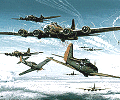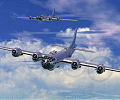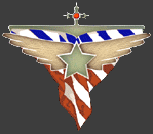Allied Units
Aircraft
Air power is essential to the Allied war effort. The efforts of the RAF and the many ex-patriot fliers who joined them in the Battle of Britian ensured the survival of the British Isles as a fortress of freedom and democracy. This gave the Allies a base from which to build up their forces and eventually to launch their invasion of France four years later. Air power was used in place of ground forces to launch devastating strategic attacks against enemy production centres. The overwhelming production of high quality fighters helped the Allies to gain air superiourity giving them the ability to use air support to assist their ground forces in France. The impact of these attacks can be seen as soon as the Germans began trying to move out of Normandy, with the near total destruction of their war machines in the Falaise pocket. Many soliders returned to Germany with only what they were carrying.
 Hawker
Hawker Hurricane
 Supermarine
Supermarine Spitfire
 Supermarine
Supermarine Spitfire VC
 Curtiss
Curtiss P-40
 P-51
P-51 Mustang
 P-47
P-47 Thunderbolt
 de Havilland
de Havilland Mosquito
 B-25
B-25 Mitchell
 B-17 Flying
B-17 Flying Fortress
 Avro
Avro Lancaster
 Hamilcar
Hamilcar Glider
 Douglas
Douglas DC-3
 B-29
B-29 Stratofortress
 Back
Back
Hawker Hurricane
Tech:
StartCost:
1170 (operate in pairs)Rebate On Map Exit:
1053Recharge Time:
8 mins 8 secsEndurance:
4 mins 30 secsHealth:
230Firepower:
6 (anti-air, rapid fire)Inbound Speed:
264Maximum Reserve Wings:
1 (2 aircraft)The Hawker Hurricane is a first generation monoplane fighter built in the late 1930s to update the RAFs fighter wing under the fighters first policy bolstering the RAFs defensive capability at the expense of offensive bombers. The Hurricane is a good aircraft but operates in the shadow of the superiour Spitfire. Nevertheless they should not be underestimated as an effective fighter. They are capable of holding their own against enemy fighters, and shredding enemy bombers with their eight machineguns.
 Back
Back
Supermarine Spitfire
Tech:
Level 1Cost:
1440 (operate in pairs)Rebate On Map Exit:
1296Recharge Time:
5 mins 1 secEndurance:
4 mins 24 secsHealth:
390Firepower:
6 (anti-air, rapid fire)Inbound Speed:
290Maximum Reserve Wings:
1 (2 aircraft)The Spitfire is an iconic fighter, equipped with the same eight machineguns as the Hurricane but far faster and more agile. It is well suited to take on enemy fighters with its superiour handling and ability to evade destructon. A common RAF tactic is for the Spitfires to engage enemy fighters while the Hurricanes go after their bombers.
 Back
Back
Supermarine Spitfire VC
Tech:
Level 3Cost:
1500 (operate in pairs)Rebate On Map Exit:
1350Recharge Time:
5 mins 1 secEndurance:
4 mins 18 secsHealth:
470Firepower:
14 (anti-air, rapid fire)Inbound Speed:
330Maximum Reserve Wings:
3 (6 aircraft)The Spitfire VC is a significant improvment over the early models. The addition of a Rolls Royce supercharged Merlin dramatically boosts the performance while new Hispano cannons replace the machineguns. The better flight characteristics and more deadly armament makes for a much more powerful aircraft, able to counter the threat from new generations of enemy fighters.
 Back
Back
Curtis P-40
Tech:
US InterventionCost:
800 (operate in pairs)Rebate On Map Exit:
720Recharge Time:
5 mins 28 secEndurance:
4 mins 42 secsHealth:
270Firepower:
9 (anti-air, rapid fire)Inbound Speed:
290Maximum Reserve Wings:
2 (4 aircraft)The P-40 is a cheap fighter able to be mass produced in great numbers. The low cost belies its great performance, with good handling and excellent offensive firepower. When operating in tandem with Spitfires the P-40s can take over the role of the Hurricanes, attacking enemy bombers while the Spitfires occupy their fighters.
 Back
Back
P-51 Mustang
Tech:
US Intervention, Level 5Cost:
910 (operate in pairs)Rebate On Map Exit:
819Recharge Time:
5 mins 28 secEndurance:
5 minsHealth:
430Firepower:
11 (anti-air, rapid fire)Inbound Speed:
351Maximum Reserve Wings:
3 (6 aircraft)The P-51 Mustang is one of the best aircraft of the war, 'the Cadillac of the skies'. Powered by Packard's supercharged version of the Rolls Royce Merlin, the Mustang is one of the fastest and most agile planes in existence. It is equipped with six Browning machineguns rounding off a deadly aircraft. Simplified mass production by General Motors and a new advanced pilot training programme makes it possible to field many of these aircraft at once at a low cost.
 Back
Back
P-47 Thunderbolt
Tech:
US InterventionCost:
1500Rebate On Map Exit:
1350Recharge Time:
50 secHealth:
250Payload:
6 HE bombs (200 damage)Payload Upgraded:
10 HVA Rockets (1000 damage)Inbound Speed:
351Maximum Reserve Strikes:
4The P-47 Thunderbolt is a fighter bomber able to fly at great speeds and engage ground targets with its bombs. These are light 150lb devices which do terrible damage to unarmoured targets but have difficulty penetrating thick armour plate. To overcome this shortcoming the P-47 can be upgraded to carry the high veloicty air-launched rockets (HVAR) also known as the 'Holy Moses'. These massive warheads are capable of dealing massive damage to even the heaviest of enemy tanks and turn the P-47 into a very powerful tank buster.
 Back
Back
de Havilland Mosquito
Tech:
Level 2Cost:
2000Rebate On Map Exit:
1800Recharge Time:
1 min 30 secsHealth:
300Payload:
12 HE bombs (300 damage)Payload Upgraded:
1 Blockbuster (6200 damage)Inbound Speed:
180Maximum Reserve Strikes:
1The de Havilland Mosquito is a fast light bomber made from plentiful plywood. Its cheap construction and high top speed make it very light and fast and nearly impossible to intercept. The Mosquito carries twelve light bombs it can use to cripple enemy positions and blast appart enemy tanks. Late in the war a new type of massive concussion bomb was developed and the Mosquitos can be upgraded to carry these huge 4000lb Blockbusters. Their huge destructive power can wipe out whole squadrons of enemy tanks or level defensive lines.
 Back
Back
B-25 Mitchell
Tech:
US InterventionCost:
3050 (operate in threes)Rebate On Map Exit:
2730Recharge Time:
1 min 26 secsHealth:
100 (high flying)Payload:
Strategic (disables target zone)Inbound Speed:
72Maximum Reserve Strikes:
1 (3 aircraft)The B-25 is a medium bomber designed to attack strategic assets. Its bombs do strategic damage, crippling the target zone and immobilising it. Until it recovers from the impact, anything caught inside will be rendered inoperable. These bombers are a great way to totally immobilise enemy production by targetting their factories, or stunning an enemy force as a prelude to a ground offensive.
 Back
Back
B-17 Flying Fortress
Tech:
US Intervention, Level 3Cost:
5000 (operate in fours)Rebate On Map Exit:
4500Recharge Time:
1 min 14 secsHealth:
220 (high flying)Payload:
Strategic (disables target zone)Inbound Speed:
72Maximum Reserve Strikes:
Level 3: 1 (4 aircraft)/ Air Tech 3: 2 (8 aircraft)The B-17 is a heavy bomber designed to attack strategic assets. It is called the flying fortress because it bristles with gun turrets. These give it cover from enemy fighters, making it a hazardous target to engage, epecially when escorted by fighters. Its bombs do strategic damage, crippling the target zone and immobilising it. Anything caught inside the target zone will be rendered inoperable until it recovers from the shock of the bombardment. These bombers are a great way to totally immobilise enemy production by targetting their factories, or stunning an enemy force as a prelude to a ground offensive. Their impact can be stepped up later in the war with twice the number of raids at any one time. A series of rolling waves can be used to utterly supress the enemy production plants, leaving them without any means to build new tanks and thus unable to continue fighting.
 Back
Back
Avro Lancaster
Tech:
Level 2Cost:
4450 (operate in fours)Rebate On Map Exit:
4005Recharge Time:
1 min 40 secsHealth:
200 (high flying)Payload:
Strategic (disables target zone)Payload Alternative:
Tallboy Bomb (Huge Explosion - total destruction) (10000 cost)Inbound Speed:
72Maximum Reserve Strikes:
Level 3: 1 (4 aircraft)The Lancaster is a heavy bomber designed to attack strategic assets. They were designed
out of desperation as a way to strike at enemy strategic assets such as production
facilities when doing so with land forces would be impractical. They are able to
devastate their target zone with strategic level destruction, causing a paralysis on
the tactical level, shutting down vehicles and production plants. By targetting enemy
factories it is possible to cripple their war effort draining them psycologically and
in the long term rendering them unable to fight.
Towards the end of the war the Tallboy earthquake bombs were developed. These massive
bombs are able to annihilate their target zone, smashing deep into the ground and then
detonating to cause a massive seismic shockwave. This blast causes total destruction
of the target zone, leveling even reinforced command bunkers.
 Back
Back
Hamilcar Glider
Tech:
Air Level 3Health:
450Payload:
1 Locust TankInbound Speed:
70Maximum Reserve Strikes:
Level 3: 1 (3 gliders)The Hamilcar is the delivery vehicle for the airborne light tank, the M22 Locust. It is towed to its target zome by a Lancaster bomber before being released to glide gracefully to the ground. Once it lands it is essentially useless and will be discarded. It is unlikely to survive the landing in a usable state anyway and they are so cheap to make that salvage isn't really necessary.
 Back
Back
Douglass DC-3
Tech:
Air Level 3Cost:
1950 (operate in threes)Rebate On Map Exit:
1750Health:
200 (high flying)Payload:
10 SAS CommandosInbound Speed:
72Maximum Reserve Strikes:
Level 3: 1 (3 aircraft)DC3s are a mass produced workhorse. As an air transport they are able to deliver supplies, key personel and perform all manner of other vital military tasks, but for the frontline commander their most striking role is as a transport for paratroopers. The DC3 is able to carry a squad of these elite troops anywhere on the battlefield, allowing them to bypass concentrations of enemy troops and strike their economy or other vital targets in the vulnerable rear. Even better, they can force troops to be redeployed from the front lines or from reserves to tackle their presence making the job of assault troops easier.
 Back
Back
B-29 Stratofortress
Tech:
Level 2Prerequisites:
Nuclear Technology 1 - 6 (25000 per technology - 150000 total)Cost:
50000 (per strike)Recharge Time:
1 min 40 secsHealth:
(extreeme altitude - unattackable)Payload:
Little Boy Bomb (total destruction within blast radius of 1400)Inbound Speed:
155Maximum Reserve Strikes:
unlimitedThe B-29 Stratofortress is a new breed of bombers able to fly in the upper atmosphere far beyond the range of enemy aircraft of FlaK guns. It ensures the successful delivery of the atomic bomb - a war-ending weapon. The pure destructive power of the atomic bomb is unparalleled and causes total destruction within the enormous blast zone. A couple of bombs is a war ending asset, wiping out enemy bases and whole armies in a single strike.
